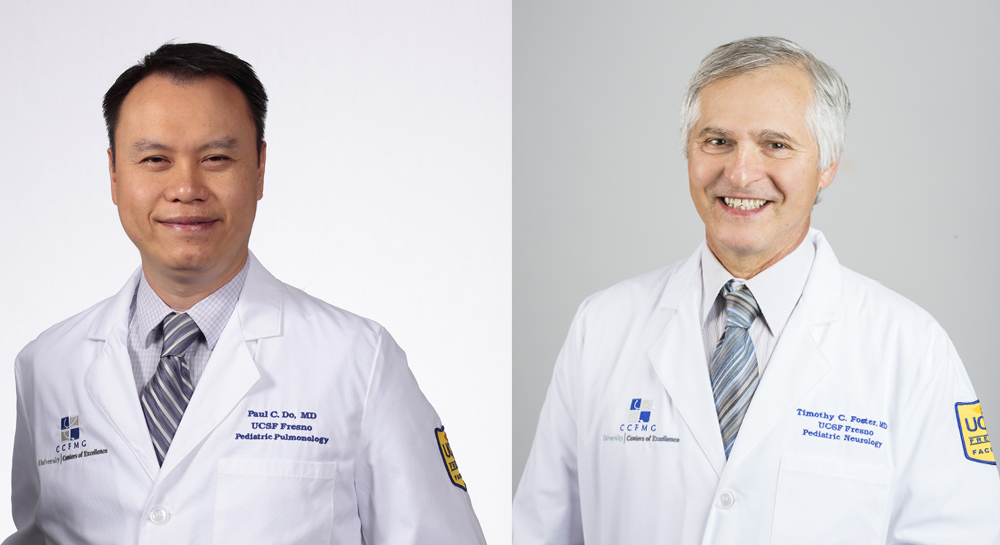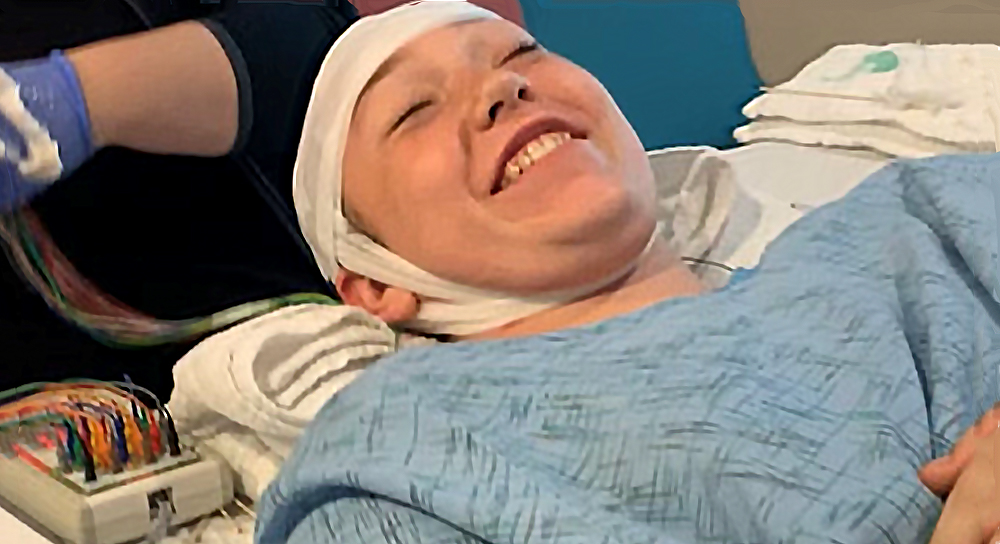She “went out” twice on the Hammer as it swung her back and forth and upside down 22 times a minute. She blacked out again on the next ride and two more times walking to the car with family friends. They took her straight to the nearest hospital in Mariposa where doctors ran all sorts of tests.
“We figure she passed out 30 times over the next four hours,” her mom Amanda Reeves describes.
More tests at a second local hospital found that Karmen was fully hydrated, her blood sugar levels were normal and there were no drugs in her system. A CT scan of her head and an EKG to look at heart rhythms turned up nothing out of the ordinary.
A see-saw of specialists and numerous tests, but no answers
Over the next year Karmen swung between specialists and medical tests to figure out why she was fainting 10 to 15 times a day. Karmen had to give up the sports she loved, take classes online (before the pandemic) and stop doing the things most normal teenagers do.
“She stopped doing dishes … People had to bring her plates of food because she’d go out and we’d have broken plates and food everywhere and Karmen in the middle of it,” says Amanda Reeves. “I was worried she’d land on shards of pottery.”
While she was trying to keep her daughter safe from daily falls, Amanda was searching for what caused Karmen’s sudden drops in blood pressure and heartbeats. Her mom kept track as she could of Karmen’s heart rate and blood pressure while she was unconscious. “The lowest we recorded (on her Apple Watch) was 29 beats a minute,” Amanda says.

The family started with a cardiologist who put Karmen on monitors at the hospital and at home. The cardiologist suggested it might be a neurological condition affecting her heart and recommended an EEG to look at brainwave function.
An hour after being hooked up, “the neurologist comes in and said there’s nothing on the EEG and she needs to see a psychologist because she’s making it all up in her head,” says Amanda. “The psychologist called it ‘conversion disorder’ from either being traumatized as a child or she needed extra attention and her brain convinced herself this was the way to get it.”
Three more ambulance rides down the mountain and two psychologists later, conversion disorder was ruled out. There had been no traumatic event in Karmen’s past — other than fainting in grocery stores and the middle of high school. “It’s scary to wake up and see everyone there,” Karmen describes what she endured. “I’ve had headaches, but no concussions and nothing broken. Just scrapes and bruises.”
Increased access to pediatric specialty care here in the Valley
Stanford University Medical Center was the Reeves family’s next stop. Stanford reviewed her case and agreed with the original neurologist that it looked like conversion disorder. The Stanford neurologist recommended a psychologist in her own backyard.
A high school friend with another rare condition that caused similar, frequent blackouts suggested they try her neurologist, Dr. Timothy Foster, who heads the pediatric Dysautonomia Clinic on the Community Regional Medical Center campus in Fresno. After one conversation with the Reeves family, Dr. Foster suspected Karmen had that often misdiagnosed condition.
Having access to pediatric specialists like those at Community’s Dysautonomia Clinic reduces hospital stays, complications and healthcare costs — and improves the quality of life for children with complex and chronic health conditions. Statewide, children have access to three times as many subspecialists as they do in the Central San Joaquin Valley. There’s one pediatric specialist for every 10,000 to 18,000 children in the Valley compared to 1 pediatric specialist for every 5,460 children statewide, a UCLA Center for Health Policy Research found.
Community has been working to fill that gap with its 40-year partnership with UCSF Fresno to train more pediatric specialists through a 10-year agreement with UCSF Benioff signed in 2015 to expand specialty medical care for our region’s children. Under that agreement, Community has added 38 pediatric sub-specialists to its downtown Fresno campus, built a 12-bed pediatric intensive care unit and set up telemedicine access to even more pediatric specialists at UCSF Benioff Children’s Hospital, ranked among the nation’s top 20 children’s hospitals.
Having access to a collaborative team of experts was key for Karmen and her family once she was diagnosed with dysautonomia.
Not-so-rare condition that’s difficult to diagnose
Dysautonomia, explains Dr. Foster, “is an umbrella term that we use to describe conditions that arise from a dysfunction of the autonomic nervous system, the part of the brain that’s responsible for regulating homeostasis. Those are all the unconscious functions of the body like the heart, bowels, the digestive system and the endocrine (hormone) system.”
An estimated one out of every 100 teenagers suffers episodes of lightheadedness, fainting, racing heart, shortness of breath, temperature fluctuations, nausea and shaking when they stand up suddenly. But often these are brushed off as dehydration, over-exertion or low blood sugar, or better known as dysregulation.
Unless dysregulation episodes are severe or as frequent as Karmen’s they often go undiagnosed. “If you just look at one thing, you are not going to find it,” says Dr. Foster, an assistant professor with UCSF Fresno department of pediatrics.
When temperature disruptions are the main complaint, dysautonomia looks like a thyroid problem. Or it may be misdiagnosed as Crohn’s disease or inflammatory bowel disease. “We’ve seen kids come to us with a diagnosis of ADD (attention deficit disorder) and that’s not it,” Dr. Foster says. “They’re just in such a fog they’re seen as being inattentive in the classroom, but then when you see more symptoms you can zero in on it.”
One of the main things Dr. Foster looks for is an inability to maintain blood flow or pressure when shifting from reclining to sitting up or standing. That’s fairly common in dysautonomia.
Collaboration from multi-specialty team is key
It takes multiple tests and specialists coming together to collaborate, identify and treat dysautonomia.
 “It seems like every kid is different, that’s why we try to get all the different specialists involved,” Dr. Foster says. “The symptoms are always very weird, like a bunch of GI problems, and their periods get really weird. There’s tons of neurological stuff like fainting and brain fog, sweating, temperature dysregulation, vision problems and ringing in the ears. And it’s often chronic and debilitating and it can get worse if you don’t figure out how to turn things around.”
“It seems like every kid is different, that’s why we try to get all the different specialists involved,” Dr. Foster says. “The symptoms are always very weird, like a bunch of GI problems, and their periods get really weird. There’s tons of neurological stuff like fainting and brain fog, sweating, temperature dysregulation, vision problems and ringing in the ears. And it’s often chronic and debilitating and it can get worse if you don’t figure out how to turn things around.”
Dr. Paul Do, a pediatric pulmonologist who is on Karmen’s dysautonomia team, says he knows many doctors who don’t see the umbrella term as a real disease, but rather a convenient term used when the causes of symptoms are difficult to pinpoint. Dr. Do, a member of the UCSF Fresno faculty, specializes in cystic fibrosis and asthma patients. He’s been working to help dysautonomia patients with breathing dysregulation and to reduce chronic and subtle inflammation that’s often a part of this condition.
Karmen’s experience of see-sawing between specialists is a familiar one to Dr. Foster: “We see the odysseys these families go through. Families express a lot of gratitude that we are validating their symptoms.”
During her first clinic visit, Karmen saw Drs. Foster and Do, plus a pediatric cardiologist and physician’s assistant. “I’ve never been in a room with four doctors before,” she says with wonder. “It was good they were all talking to each other — and talking to me and not my mom. It felt so nice that they were listening to me.”
Combination of stress, illness and inflammation puts teens at risk
Karmen fits the profile of a typical teen with dysautonomia. She’s a top student and was playing volleyball and basketball as a starter. And the day before stepping on the carnival ride, she was sick with vague viral symptoms — a headache, nausea and fatigue.
“We think it’s a combination of things,” Dr. Foster explains how dysautonomia starts. “So you may have a genetic risk and then you have inflammation from an illness, and then who knows what she was eating at that fair, maybe a lot of poor-quality carbohydrates, and then there were all the emotions and excitement of the ride. And that was enough to push her over the edge.”
The body and brain work like a see-saw to keep in balance, he explains to patients. When the body moves, the heart rate and blood pressure adjust to compensate. When you step out into the cold, you may involuntarily shudder to raise your body temperature. “It’s like a see-saw and the see-saw got pushed all the way down and then patients get all these symptoms,” Dr. Foster says.
The Dysautonomia Clinic most often sees high-functioning teens who are athletes or highly competitive scholars and they experience some sort of illness like mononucleosis at the same time they have another strain like psychological stress, an injury or a junk-food diet. And the clinic is seeing an increase in patients, Dr. Fosters says, either because doctors are getting better at diagnosing the disorder or more people are actually experiencing this dysregulation.
“I think there are more people getting it with modern living,” he adds. “We don’t know if it’s a combination of overuse (of the brain) and all the cortisol and all the stress hormones of being really driven that help lead to this dysregulation. You’re kind of calibrated to be a certain way and then you get out of sync and you can’t get back in sync. And that’s where we focus our treatment on.”
Treatment focus on bringing the body back in balance
 After testing to identify metabolic abnormalities, inflammatory conditions and hormonal issues, the dysautonomia multi-specialty team coordinates treatment of all the symptoms “One of our main goals is to improve their blood flow with circulatory support,” says Dr. Foster. “We also focus more on metabolism and autoimmune disease, nutrition and psychological stuff.”
After testing to identify metabolic abnormalities, inflammatory conditions and hormonal issues, the dysautonomia multi-specialty team coordinates treatment of all the symptoms “One of our main goals is to improve their blood flow with circulatory support,” says Dr. Foster. “We also focus more on metabolism and autoimmune disease, nutrition and psychological stuff.”
Doctors work “to establish balance between the two branches of the autonomic nervous system. You have your sympathetic and your parasympathetic and we try to get those in line,” he says.
Occasionally that also includes psychological support — often because kids with dysautonomia suffer the trauma that comes with being chronically ill, the embarrassments of fainting in front of strangers and the grief of not being able to do sports or go to school. “Usually we try a combination of things. You have to work every aspect of it to help the patient get better,” says Dr. Foster.
For Karmen, treatment includes taking 15 pills at different times throughout the day, using CBD oil for side effects of the medications, keeping stress to a minimum, sleeping more and exercising less. “No heavy exercise is challenging with basketball. I can’t really condition hard, but I can play ball — just not the whole game,” she says.
Karmen used to dream about playing basketball in college, but now she says, “I want a job and I want to drive sooo bad.”
After finding the Dysautonomia Clinic, she and her family see more hope for a normal future without fainting. Karmen boasts, “I haven’t passed out for 99 days!”
Community’s Commitment to Advancing Clinical Quality
Our mission of improving the health of our region is dependent on continually enhancing our medical expertise. We aim to rank among the nation’s top hospitals in delivering measurable quality care and investing in best practices and innovative technology. Read more stories.



.jpg)


